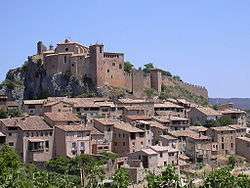Alquézar
| Alquézar Alquezra | ||
|---|---|---|
| Municipality | ||
|
View of Alquézar with Collegiate church on the top | ||
| ||
 Alquézar Location in Spain | ||
| Coordinates: 42°10′26″N 0°01′38″W / 42.17389°N 0.02722°WCoordinates: 42°10′26″N 0°01′38″W / 42.17389°N 0.02722°W | ||
| Country |
| |
| Autonomous community |
| |
| Province | Huesca | |
| Comarca | Somontano de Barbastro | |
| Judicial district | Barbastro[1] | |
| Government | ||
| • Type | Mayor-council | |
| • Mayor | José Mariano Altemir Lascorz (PSOE-Aragón) | |
| Area | ||
| • Total | 32.36 km2 (12.49 sq mi) | |
| Elevation | 660 m (2,170 ft) | |
| Population (2012) | ||
| • Total | 301 | |
| • Density | 9.3/km2 (24/sq mi) | |
| Demonym(s) | Alquezrano/a | |
| Time zone | CET (UTC+1) | |
| • Summer (DST) | CEST (UTC+2) | |
| Postal code | 22145 | |
| Website | Official website | |
Alquézar (Alquezra in Aragonese)[2] is a municipality in the province of Huesca, in the autonomous community of Aragon, Spain. In 2012, it had a population of 301.
Overview
Situated on a limestone outcrop of Eocene age to the west of the canyon of the Rio Vero river in the Sierra de Guara national park, the village has grown around a castle and the Colegiata de Alquézar of Santa Maria (consecrated in 1099). The limestone is rich in nummulites (large foraminifera) from the shallow marine depositional environment.
The name comes from Arabic القصر al qaçr, "fort, castle" (renamed as Alcazar in Spanish). Jalaf ibn Rasid ordered its construction and it became the main defensive point of Barbastro against the incipient cristians realms in the Sobrarbe's County.
Since Alquézar is situated in the Sierra de Guara, there is much tourist activity in outdoor pursuits such as canyoning, walking, rock climbing and abseiling, as well as ornithology (since eagles nest on the steep faces of the Rio Vero canyon). Several campsites and outdoor activity companies cater for this interest.
The surrounding area to the south towards Barbastro in the direction of the flatter Ebro basin is part of the Somontano, an area known for its fine wines. There are more than 60 limestone caves with prehistoric cave paintings which has led to the region being declared a World Heritage Site by UNESCO in 1998. An example is the cave at Arpán on the A-2205 road heading north towards Bárcabo.
Gallery
-

View of Saint Michael's church from the Collegiate church
-
Town's view from above
References
External links
 Media related to Alquézar at Wikimedia Commons
Media related to Alquézar at Wikimedia Commons- Alquézar Tourist Office's website (Spanish)
- Somontano information website
- Alquézar page on information website
- Somontano prehistoric cave paintings

